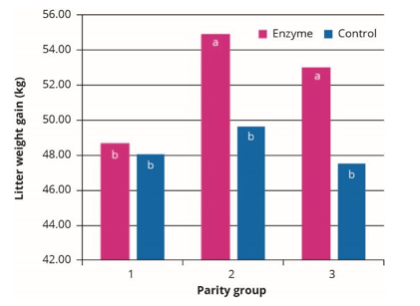上文提到,基因、营养和健康状况的改善,使母猪的生产性能有所提高。而添加碳水化合物酶可以提高泌乳母猪的性能。本文将继续介绍碳水化合物酶添加于母猪饲料的试验过程及结果,以及碳水化合物酶对于泌乳母猪的体况以及仔猪的性能到底有哪些影响。
Sow condition and body reserves
母猪体况与身体储备
The sows studied lost 21kg in average of body weight during lactation. That loss was significantly different between parity groups – lower in group 1 and 3 than in group 2. The addition of the carbohydrase complex reduced body weight loss in all parity groups (Figure 1). The average reduction in weight loss of 3kg per sow, represents 1-2% of their body weight. Primiparous sows fed carbohydrases mobilised a significantly smaller percentage of their body stores. Those effects can be explained by better feed digestibility.
研究的母猪在哺乳期平均体重下降了21公斤。这一损失在奇偶校验组之间有显著差异——第1组和第3组比第2组低。碳水化合物酶复合物的添加降低了所有胎次组的体重下降(图1)。每头母猪平均减少体重3kg,相当于其体重的1-2%。初产母猪用碳水化合物酶喂养后,其体内储存的碳水化合物的比例明显降低。这些影响可以归因于更高的饲料消化率。
Figure 1 – Carbohydrase complex reduced sow body weight loss in all parity groups.
图1 -碳水化合物酶复合物降低了所有胎次组母猪的体重下降。

In both high- and low-density diets, specific carbohydrases complex addition increased dry matter, organic matter and energy digestibility. That means that the sows were able to access a larger amount of nutrients from the diet. Those effects were irrespective of dry matter intake, which was statistically the same between the four treatments. However, feed and energy intake did increase with parity. Primiparous sows fed the control diets had a lower energy intake and lost more weight than multiparous sows. A clear relationship was found between net energy intake, body weight variation and litter weight gain.
在高、低密度日粮中,特定碳水化合物酶复合物的添加均可提高干物质、有机质和能量消化率。这意味着母猪能够从食物中获得更多的营养。这些影响与干物质的摄入量无关,这在四种治疗方法在统计意义上是相同的。然而,饲料和能量的摄入量确实随着胎次而增加。与多胎母猪相比,饲喂对照饲料的初产母猪能量摄入量较低,体重减轻较多。净能量摄入、体重变化与窝重增长之间存在明显的关联。
Nutrient partitioning
养分分配
From the results of sows fed carbohydrases a higher net energy (NE) intake was estimated and compared with bodyweight loss. Energy was partitioned differently, between growth and milk production, depending on parity and sow condition. The study showed that additional NE intake of primiparous sows was preferentially used to improve their body condition, rather than for milk production. That strategy, associated with incomplete development of primiparous sows, will help to reduce body weight loss – protecting her long-term performance. In older sows, with higher levels of back fat, it is more important to optimise milk production and raise healthy litters.
根据喂食碳水化合物酶的母猪的结果,估计净能量(NE)摄入量较高,并与体重下降进行了比较。能量的分配在生长和分泌乳汁之间是不同的,取决于胎次和母猪的体况。研究表明,增加初生母猪的净能量摄入量主要是为了改善它们的身体状况,而不是为了产奶。这种策略与初生母猪发育不完全有关,将有助于减轻体重——保护母猪的长期健康。在背膘较厚的老年母猪中,优化产奶量和培育健康的幼崽更为重要。
Litter weight gain is affected by feed intake, particularly in primiparous sows – due to their higher requirements for growth and lower body reserves. The use of this carbohydrase complex increased litter weight gain up to weaning (see Figure 2). That effect was bigger in litters from multiparous sows – possibly due to variations in body weight and litter weight gain – or because of differences in nutrient partitioning. Weight at weaning is a predictor of future pig performance. A good start being key to efficient growth, health and optimal days to slaughter.
仔猪的体重增长受采食量的影响,尤其是初生母猪,因为它们对生长的要求较高,身体储备较低。这种碳水化合物酶复合物的使用在断奶前增加了仔猪的窝重增长(见图2)。这种影响在多胎母猪的产仔中更大——可能是由于体重和窝重增长的变化——或者由于营养分配的差异。断奶时的体重是预测猪未来表现的一个指标。良好的开端是高效生长、健康和最佳屠宰天数的关键。
Figure 2 – Carbohydrase complex increased piglet liveweight gain in all parity groups.
图2 –糖水化合物复合酶增加了所有胎次组仔猪的体重增加。

Conclusion
结论
In order for a sow to rear a litter and return to service in a good body condition after the piglets are weaned, she needs to ingest a sufficient amount of nutrients to produce milk, without losing too much weight. Despite an increase in feed intake at the onset of lactation, sows can lose up to 10% of their body weight. Reducing the loss of body reserves has a significant effect on subsequent reproductive cycles. Therefore, strategies to improve the nutrient intake of sows will benefit both health and economic performance.
为了使母猪在仔猪断奶后能以良好的身体状况生产一窝仔猪,母猪需要摄取足够的营养物质,在不减少太多体重的情况下产奶。尽管在哺乳期开始时增加了饲料的摄入量,母猪仍然可能减掉10%的体重。减少身体储备的损失对随后的生殖周期有重大影响。因此,提高母猪营养摄入量的策略将有利于健康和经济效益。
From this meta-analysis, it’s clear that this carbohydrase complex is a solution to alleviate the effects caused by high sow productivity. Supplementation reduced sow body weight loss and increased diet digestibility. By increasing daily energy intake, carbohydrases are aiding the development of sows. It also results in larger and heavier litters of piglets, which as a predictor of future pig performance, is economically important for pig producers.
从这一整合分析,很明显,这种碳水化合物复合酶是一种解决方案,以减轻由高母猪生产力造成的影响。补充维生素可以降低母猪的体重减轻,增加饲料的消化率。通过增加每天的能量摄入,碳水化合物酶有助于母猪的发育。它还有助于母猪生产出更多、更大的仔猪,这是预测未来猪性能的一个指标,对养猪户来说具有重要的经济意义。
来源:Pig Progress
作者:Pierre Cozannet
(文/爱猪网记者刘坤颖编译,爱猪网原创,转载请注明出处)










